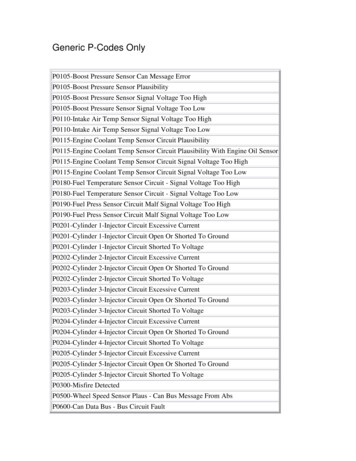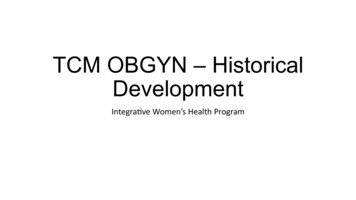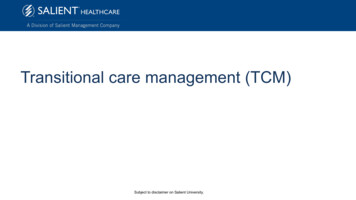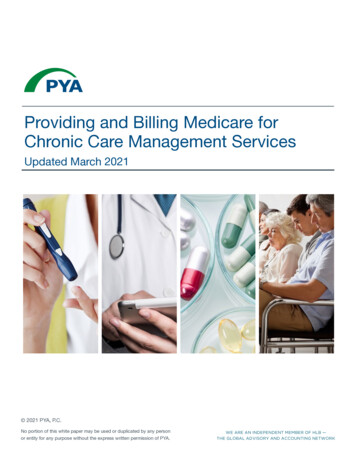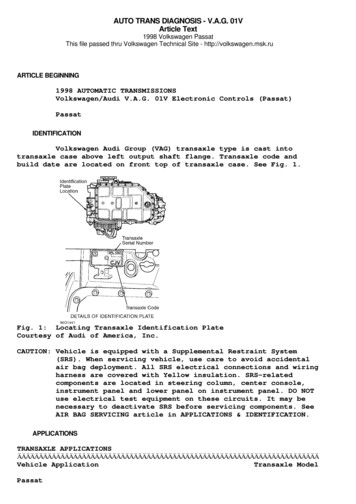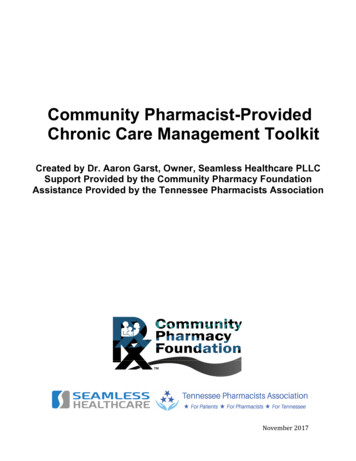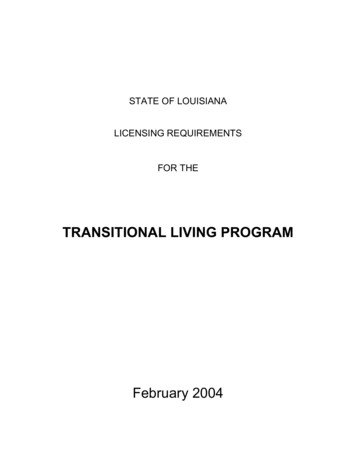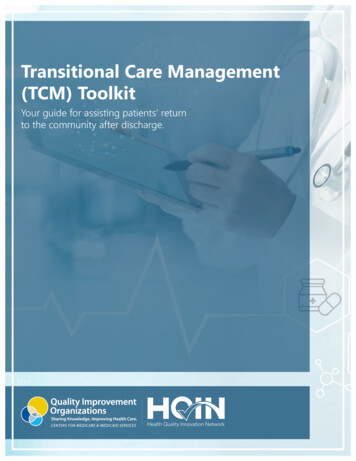
Transcription
Transitional Care Management(TCM) ToolkitYour guide for assisting patients’ returnto the community after discharge.
According to the Centers for Medicare & Medicaid Services (CMS), a recent analysis found that ”thebeneficiaries who received TCM services demonstrated reduced readmission rates, lower mortality,and decreased health care costs. Based upon these findings, we believe that increasing utilization ofmedically necessary TCM services could positively affect patient outcomes.”IndexOverview3Rationale for TCM3Fiscal Performance4Process Performance4Interactive Contact5Considerations5Face-to-Face Visit5Billing for TCM Services6Non-Face-to-Face Services7Medical Decision Making8Documenting TCM Services8Appendix A: TCM Workflow Example9Appendix B: Sample TCM Discharge and Communications Template10Appendix C: TCM Face-to-Face Visit Template11www.hqin.org 877.731.47462
OverviewThank you for using the TCM toolkit. The Health Quality Innovation Network (HQIN)offers this guide for your team to implement or expand TCM for your Medicarepopulation that have been discharged from a facility to the community. Use this guideto assist patients and caregivers mitigate unnecessary readmissions and improve yourunderstanding of TCM services including service requirements, patient interactions,workflows, documentation, and billing.TCM services can be provided to Medicare beneficiaries by their primary care physicianor clinical team when discharged from an appropriate facility defined by CMS. TCMservices require moderate or high-complexity medical decision making by the receivingprovider. Initial contact with the patient must be made within two business days ofdischarge.The service period is 30 days beginning on the date a beneficiary is discharged froma hospital or other facility. The date of service is the date the provider completes therequired face-to-face visit.During this time period, the following three services must be provided.1. An interactive communication2. Specific non-face-to-face services3. A face-to-face visitRationale for TCMApproximately 17% of Medicare beneficiaries are readmitted to the hospital within 30days of discharge.1 CMS reimburses for TCM services, supporting healthy transitionsafter hospital stays. TCM services ensure that your highest risk patients receive the carethey need immediately after discharge from a hospital or other facility.TCM services help to mitigate readmission by closely monitoring many of the riskspatients can experience after discharge from a facility. Common risk factors include butare not limited to: Adverse Drug Events (ADEs) can be avoided through comprehensivemedication review or Blue Bag review upon discharge to ensure the patientand caregiver understand the correct medication they should be taking. Sepsis is one of the leading causes of readmission especially for patients whohave experienced invasive medical procedures.31Characteristics of 30-Day All-Cause Hospital Readmissions, 2010-2016 (ahrq.gov)
Cardiac related complications are also a major cause of readmissions and TCMservices can help identify potential complications through regular contactwith the patient and potentially transition those qualifying into Chronic CareManagement (CCM) services. Discharges for COVID-19 related admissions have become a more recent concernespecially with an increased risk for pneumonia. Avoidable ED visits, inpatient stays and observation stays, including those ofmulti-visit patients.Implementing TCM services into practices provides added value to patients andfamilies, health systems and payers along with an added revenue opportunity.Fiscal PerformanceTo understand the fiscal impact of TCM services on your bottom line, use HQIN’s TCMRevenue Estimation Tool to estimate potential revenue if you maximize TCM at yourpractice, pharmacy or organization. Other benefits of TCM services include efficienciesin time and resources due to reduced readmissions and related work and cost-savingsor improved incentive performance payments with payers or programs.Process PerformanceMeasure the percent of each unique patient’s eligible discharge event where TCMservices were provided.25 eligible beneficiariesdischarged in past 12 monthswho received TCM services 25% Performance100 eligible beneficiariesdischarged in past 12 months4
Interactive ContactAn interactive contact must be made by the practice with the beneficiary and/or caregiver, as appropriate, within two business days following discharge of thebeneficiary to the community setting. Interactive communication can include directcontact, telephone, or electronic (i.e., patient portal or other secure electronic methods).Interactive communication may be made by the provider or any member of their clinicalstaff with capacity to address patient needs beyond scheduling follow-up care.ConsiderationsDue to the reliance on hospitals and/or allowable facilities, physician practices shouldwork to establish proactive coordination with local discharging facilities about thebenefits of TCM and improve collaboration to: Achieve time sensitive initial contact requirements.Help facilities avoid potential penalties for readmissions.Improve medication reconciliation and follow-up treatment.Improve coordination of post-discharge care.Face-to-Face VisitOne face-to-face visit must be furnished unless you determine they aren’t medicallyindicated or needed. This visit must be completed within certain timeframes asdescribed in Figure 1. Health care practitioners such as Physicians (any specialty) andNon-Physician Practitioners (NPPs), must provide the services associated with the TCMface-to-face visit and can supervise auxiliary personnel, which includes clinical staff.The visit can be provided via telephone or telehealth as a substitute for an in-personencounter. Telehealth services must be HIPAA secure with audio and video capabilities.The face-to-face visit is part of the TCM service, and you should not report it separately.Figure 1 - TCM Services SummaryModerate ComplexityCPT 99495Communication w/Patient/caregiver within2 business days of dischargeA face-to-face visit within 14 calendar daysof dischargeMedical decision making of at leastmoderate complexity during service period2021 National non-facility price 207.96*High ComplexityCPT 99496Communication w/ patient/caregiver within2 business days of dischargeA face-to-face visit within 7 calendar daysof dischargeMedical decision making of at least highcomplexity during service period2021 National non-facility price 281.59**Codes and pricing current as of May 19, 2021. For most current rates, refer to the National Physician Fee Schedule Tool.NOTE for FQHC: Within the COVID-19 PHE period, TCM provided by distant site Telehealth services,Physician’s code 99495/99496 accordingly but FQHC bills G2025 to CMS, CMS pays 99.45.5Both codes require medication reconciliation and management, which must bedocumented no later than the date of the face-to-face visit.
Billing for TCM Services Only one provider can bill per patient– Establish the primary provider in charge of care coordination prior todischarge. The discharging physician should communicate to the patient whowill be providing the TCM services and any available appointment and contactinformation. Coding frequency is once per patient per admission– Applies to both new and established patients. The required face-to-face visit is part of the TCM service and is not reportedseparately. The required face-to-face visit may not take place the same day as discharge daymanagement services. Additional E/M services provided AFTER the face-to-face visit can be billedseparately. Additional visits during the service period of 30 days can be billed using a standardE/M office visit code. (99213/99214) Ancillary services to include labs, radiology, EKG, etc. can be billed on the same day. Services such as care plan oversite, end-stage renal disease, and chronic caremanagement can now be billed concurrently during the service period. Billing should be complete at the end of the 30-day post-discharge period. You may not bill the TCM if there was no successful communication within the30-day period between the facility discharge and the date of service for the postdischarge TCM code.As of January 1, 2020, the following services and codes may now complement TCM andbe used concurrently as deemed medically necessary. Refer to the federal register linksbelow. Exception: FQHC/RHC limitations for TCM and other services may still apply: SeeFQHC/RHC FAQ link below.ServicesProlonged Services without Direct Patient ContactHome and Outpatient International Normalized Ratio (INR)Monitoring ServicesEnd-Stage Renal Disease Services (patients who are 20 years)Analysis of DataComplex Chronic Care Management ServicesNon-Complex Chronic Care Management Services*Care Plan Oversight ServicesCodes99358, 9935993792, 937939060, 90961, 90962, 90966, 909709909199487, 9948999490, 99491, 99439G0181, G0182Important Notes: This table represents Medicare only and is new as of the Medicare program CY 2020 Revisions to Payment Policies Under thePhysicians Fee Schedule. Medicare Advantage plans and commercial payers may have different rules. Please verify with those payers, as needed. Thechanges made by CMS, documented in the federal register, do not appear to be reflected in the AMA CPT coding rules at the time of this toolkitdevelopment. Please refer to the most recent changes to TCM services in the CMS MLN TCM Booklet.Reference most current updates here: 7*Non-Complex CCM Services Changes: 7FQHC/RHC FAQ: ice-Payment/FQHCPPS/Downloads/FQHC-RHC-FAQs.pdf6
Non-Face-to-Face ServicesNon-face-to-face services such as arranging of follow-up appointments, obtaining and reviewingrecords, providing education to the patient caregiver, and interaction with healthcare professionalsfor coordinating care which must be provided to the beneficiary, unless the physician determines thatthey are not medically indicated or needed.The TCM codes are care management codes. As care management codes, auxiliary personnel mayprovide the non-face-to-face services of TCM under the general supervision of the physician or NPPsubject to applicable state law, scope of practice, and the Medicare Physician Fee Schedule (PFS)“incident to” rules and regulations.Under the direction of the physician, clinical staff (i.e., pharmacist) or Non-Physician Practitioners(NPP) may furnish TCM services.NPPs include the following: Certified Nurse Midwife (CNM) Clinical Nurse Specialist (CNS) 7 Nurse Practitioner (NP)Physician Assistant (PA)Services Provided by Physicians or NPPsObtain and review discharge information (for example, dischargesummary or continuity of care documents)Review the need for or follow-up on pending diagnostic tests andtreatmentsInteract with other health care professionals who will assume orreassume care of the beneficiary’s system-specific problemsProvide education to the beneficiary, family, guardian, and/or caregiverEstablish or re-establish referrals and arrange for needed communityresourcesAssist in scheduling required follow-up with community providers andservicesTCM Services Provided by Auxiliary PersonnelUnder Physician or NPP General SupervisionCommunicate with the patientCommunicate with agencies and community service providers thebeneficiary usesProvide education to the beneficiary, family, guardian, and/or caretaker tosupport self-management, independent living, and activities of daily livingAssess and support treatment adherence including medicationmanagementIdentify available community and health resourcesAssist the beneficiary and/or family in accessing needed care and services
Medical Decision MakingMedical decision making refers to the complexity of establishing a diagnosis and/orselecting a management option, which is determined by considering these factors: The number of possible diagnoses and/or the number of management optionsthat must be considered. The amount and/or complexity of medical records, diagnostic tests, and/or otherinformation that must be obtained, reviewed, and analyzed. The risk of significant complications, morbidity, and/or mortality as well ascomorbidities associated with the patient’s presenting problem(s), the diagnosticprocedure(s), and/or the possible management options.Refer to CMS MLN E/M Service Guide for further details: Evaluation and Management Services Guide Booklet (cms.gov)Documenting TCM ServicesThe following information and details at minimum, should be documented in thepatient’s medical record: Relevant details regarding the discharge of the beneficiary and the date. The date of the interactive contact/communication that was made or attemptedwithin the required two days of discharge. The date of the required face-to-face visit: to include details of the medicationmanagement and reconciliation. The non-face-to-face services provided and dates. The level of complexity of medical decision making (moderate or high.)Defining Discharge for TCM ServicesDischarge must be from one of the following facility settings: Inpatient Acute Care HospitalInpatient Psychiatric HospitalInpatient Rehabilitation HospitalLong-term Care HospitalSkilled Nursing FacilityPartial hospitalizationHospital outpatient observationThe patient must be returned to their community setting: Patient homeVeteran’s domiciliaryRest home (e.g., boarding home, adult care home)Assisted living8
TCM Workflow ExampleInteractivecommunicationsis made withpatient within 2business days ofD/CPatient D/C’dfrom facilityThe appropriatephysicianrecieved D/Csummary andrelevant datawithin 48-72 hrs.Schedule F/Uappt within 7days to 14 daysof D/CClinical staffprovides nonf/f servicesunder physiciandirectionPatients and/or caregiversrecieveeducationon follow updischarge9TCM Serviceswith highdecision makingcomplexitywithin 7 days ofD/CPatients’ assessedfor med adherence& reconciliationis performed(required, no laterthan the F/F Visit)Code99496A face toface medicalencounter isrenderedTCM Serviceswith moderatedecision makingcomplexitywithin 14 days ofD/CCode99495Patients recieveassistancein accessingcommunity andhealth resourcesAppendix A
Sample TCM Dischargeand Communications TemplatePatient Name:Sources of Information:Family/Caregiver Name:Patient, family member or caregiverHospital discharge summaryDate of Contact:Other :List of recent hospitalization or ED visits:Discharge Location:Discharge Date:Home Family Member Home Non-Family Home Assisted Living Other:Diagnosis/problem:Medication Changes: Yes NoNotes:Medication list updated: Yes No Notes:Referral/Lab Needed: Yes NoNotes:Initial Communication Post-Discharge:First 2 attempts must be withing 2 business days of discharge date listed above.Continue to contact patient even if attempts past the 2 days are not ailsecuremessageother1stcallemailothersecure messagefax2ndcallemailothersecure messagefaxAdditionalcallemailothersecure messagefaxAdditionalcallemailothersecure messagefaxAdditionalcallemailothersecure messagefaxAdditionalFollow-up Appointment:Date:Within 7 days of dischargeWithin 14 days of dischargeProvider:Additional Information:Form Completed By: (Clinic Staff Member)Signed Off By: (Provider)Appendix BDate:Date:10
TCM Face-to-Face Visit TemplateTo be used by provider to document the requirements of the face-face visit.Patient Name:Appointment Date:Initial Communication Date:Made By:Medications:Medication list reconciled and updatedUpdated medication list given to patient/caregiver (print or send to portal)Patient Education:Notes/Details:Education ProvidedEducation DiscussedDurable Medical Equipment:Notes/Details:DME orderedNo DME neededCommunity Resources:Notes/DetailsAssisted Living:Home HealthHospiceProgramSupport GroupOtherReferrals:Referrals Needed: Yes NoReason(s):Referrals ate:Provider:Additional Information:Form Completed By: (Clinic Staff Member)11Date:Appendix C
Contactquestions@hqi.solutions / edIn@HQIN@HQINetwork@Health Quality Innovators (HQI)This material was prepared by Health Quality Innovators (HQI), a Quality Innovation Network-Quality Improvement Organization (QIN-QIO) undercontract with the Centers for Medicare & Medicaid Services (CMS), an agency of the U.S. Department of Health and Human Services (HHS). Viewsexpressed in this document do not necessarily reflect the official views or policy of CMS or HHS, and any reference to a specific product or entityherein does not constitute endorsement of that product or entity by CMS or HHS. 12SOW/HQI/QIN-QIO-0100-10/05/2112
Transitional Care Management (TCM) Toolkit Your guide for assisting patients' return . Sample TCM Discharge and Communications Template . 10 . Appendix C: TCM Face-to-Face Visit Template . 11 . www.hqin.org 877.731.4746 . 2 . . documentation, and billing.
